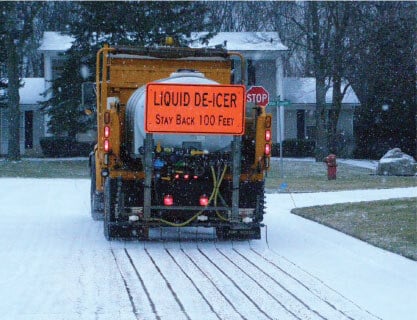Brine applications can be a game-changer with careful planning

Switching from granular rock salt to brine applications for snow removal can be a game-changer if done thoughtfully and with careful planning. Here are five items to consider when converting to salt brine use.
Equipment investment
One of the primary concerns when converting to salt brine use is the initial investment in equipment. Contractors will need to purchase or retrofit equipment to produce, store, and apply brine. This includes brine makers, storage tanks, and application equipment. While the upfront costs can be significant, the long-term savings and benefits often outweigh the initial investment.
Training and education
Proper training and education are crucial for successfully implementing brine applications. Contractors and their employees need to understand how to produce and apply brine effectively. This includes knowledge of the correct brine concentration, application rates, and timing. Investing in training programs and resources can help ensure that the transition to brine use is smooth and effective. Start with small locations and experiment with different applications to learn what works in your market.
Storage and handling
Storing and handling brine requires careful consideration. Brine needs to be stored in appropriate tanks that prevent contamination and evaporation. Additionally, contractors need to ensure that their storage facilities are equipped to handle the volume of brine required for their operations. Proper handling procedures must also be in place to prevent spills and leaks, which can be hazardous and environmentally damaging.
Weather and temperature considerations
The effectiveness of brine can be influenced by weather and temperature conditions. Brine works best when applied before a snowfall or ice event, but its effectiveness can diminish in extremely cold temperatures. Contractors need to monitor weather forecasts closely and adjust their application strategies accordingly. Understanding the limitations of brine and having contingency plans in place for extreme weather conditions is essential. Brine applications are not the magic formula to fix all of your ice control needs, however it should be viewed as one of many tools in your seasonal toolbox of goodies.
Customer education and communication
Educating customers about the benefits and effectiveness of brine applications is important for gaining their support and trust. Customers may be unfamiliar with brine and may have concerns about its effectiveness and safety. Clear communication about the advantages of brine, such as cost savings, environmental benefits, and improved safety, can help alleviate these concerns. Providing customers with information and updates about the transition to brine use can also enhance their confidence in the contractor’s services. If your clients have only seen traditional rock salt on your properties this will be a change that needs to be explained as to why you’re switching over and what to expect.
Mike McCarron is president and founder of Image Works Landscape Management, a commercial landscape maintenance and snow removal firm in the Northern Virginia market. He has 20+ years of industry experience. Email him at mike@imageworkslandscaping.com.



